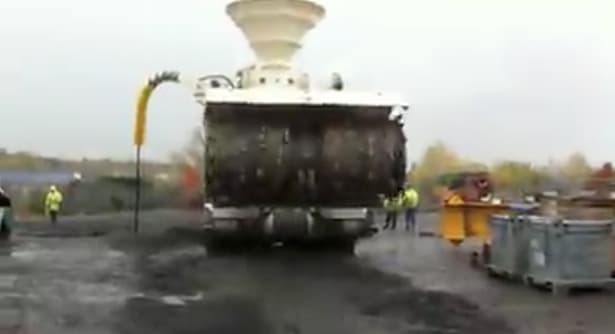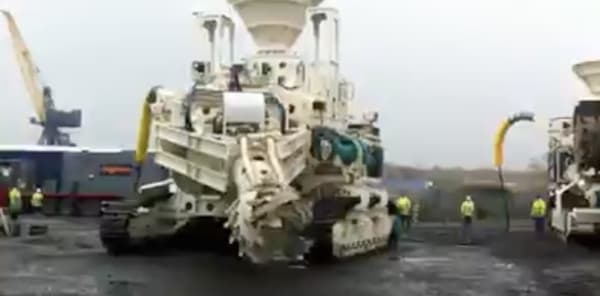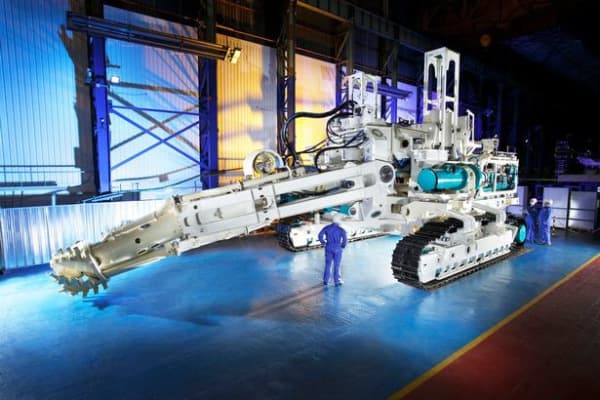250 tonne monsters ready to chew up the seafloor in PNG
The three 250 tonne mega machines that Nautilus Minerals will use to chew up the seafloor in PNG have finally been unveiled.
One can only imagine the destruction that is going to be caused and the impacts on sea life and vital fishing stocks once these mechanical giants are unleashed…

Vehicles built for Nautilus Minerals have finally been completed by Wallsend’s SMD following five years of engineering works
250-tonne underwater gold mining vehicles unveiled on Tyneside
Source: Tom Keighley | Chronicle
A trio of Tyneside-built undersea mining vehicles have been unveiled after a five-year, multi-million pound development project that has shown off the best of North East engineering.
Wallsend engineers SMD and representatives from Canada’s Nautilus Minerals were on hand yesterday to give a live demonstration of the three Nautilus vehicles, each weighing around 250 tonnes.
Delivery of the vehicles is the culmination of a $100m phase in Nautilus’ project to mine high grade iron ore nodules and gold from the sea floor.
The three pieces of kit – a bulk cutter, an auxiliary cutter and a collection machine – are now due to be taken to an unnamed location for testing in shallow waters before they loaded onto a specially built vessel and deployed in the Pacific Ocean.

The machines are designed to break rock with much greater forces than their land-based counterparts and can only be operated on land at low temperatures for fear of overheating
All three will operate at depths of around 1,500m in temperatures of 2.6 degrees celsius, controlled remotely by teams on board the vessel using sonar and mapping technologies. Ultimately a crew of around 130 will help to deploy and operate the machines from Nautilus’ vessel.
At SMD’s Wallsend yard, international media were treated to a live demonstration of the machines, which feature components made by the likes of Caterpillar and North East neighbours Pearson Engineering.
Workers explained that Nautilus machines are designed to break rock with much greater forces than their land-based counterparts and can only be operated on land at low temperatures for fear of overheating.
Nautilus Mineral’s chief executive Mike Johnston flew to Tyneside for the unveiling. He said: “We’re opening up a huge potential for seabed minerals which requires the sort of expertise that SMD has.
“Before we started this project we ran a design challenge and SMD were always in the top two companies, and they won it comprehensively. Everybody in the oil and gas space knows about their prowess.
“On the vessel side of the operation we’ve got some of the world’s best companies involved, including the likes of Siemens and Rolls Royce, so it only natural that we ended up with SMD.”

Nautilus Mineral' Auxillary cutter
North East-based engineers will now follow the Nautilus machines to China where they go through testing before mining is expected to begin in 2017.
As the first project of its kind, international eyes are now on the Nautilus project to see if seabed mining can be commercially viable.
Mike Jones, deputy chief executive officer at SMD, said: “It’s very much been a joint effort combining Nautilus’ expertise in mining and SMD’s expertise in subsea equipment. There’s still quite a lot to do in order to put these machines to work. We’ll work together in the testing phase, which comes next, and the initial working phase.
“From there it’s a case of learning. These machines are the first of their type and we’ll work with Nautilus to build future generations of the technology.”
Nautilus – a company listed on the Toronto Stock Exchange – have been given the go-ahead to mine at their first site off the coast of Papua New Guinea, and also hold licences for other sites which will require environmental permits before operations can begin.
The firm has faced opposition from environmental groups and non-governmental organisations who fear the mining processes will cause irrevocable damage to the deep sea ecosystem.
Mr Johnston added: “There’s a lot of stuff said about seafloor mining which just isn’t true. It’s going to be very hard for some of these people to stand on the sidelines, when we’re operational, and see that these things just aren’t happening.
“We’re now talking to other governments where we hold licences in order to progress them. Next year the International Seabed Authority is set to publish the first set of regulations on the exploitation of seabed nodules, and that will set the ball rolling for permits in international waters – which we are keen to do.”
